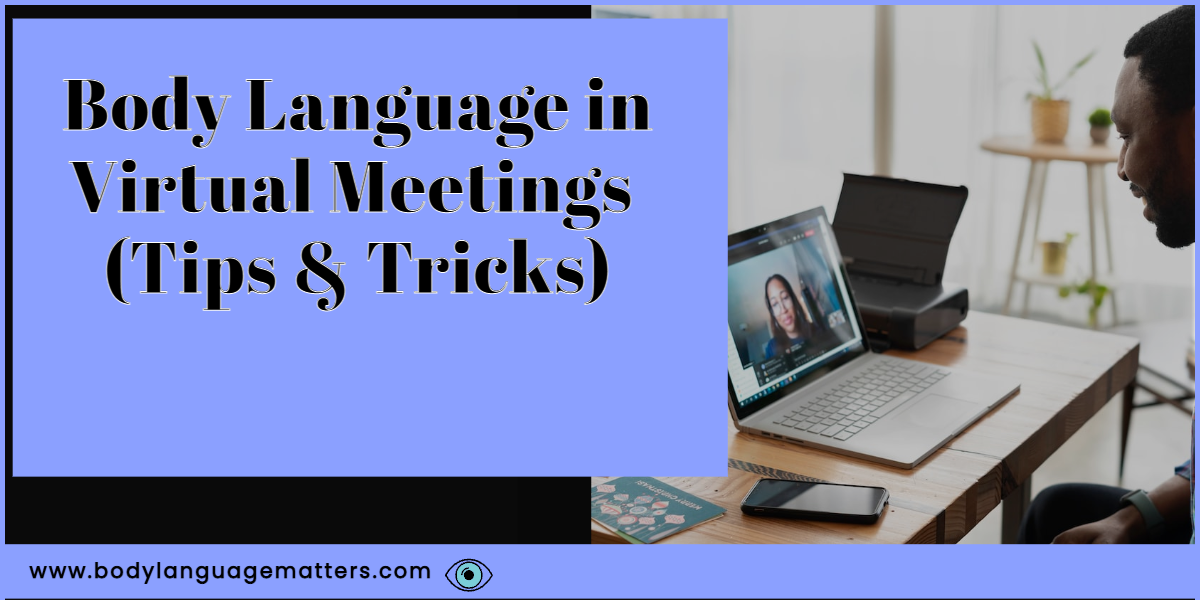When it comes to virtual meetings and body language there are some tips and tricks you can do right away to make a great impression or even improve your nonverbals. As we’ve moved into a hybrid digital age of working, it’s more important than ever to know how we’re presenting ourselves and what our body language says about us.
It helps us understand others better in virtual meetings and can even make the difference between not connecting and having an effective conversation with all our co-workers. In this post, we will be exploring the different types of body language in virtual meetings and how you can use them to become the best virtual you.
Most experts agree that the best digital body language is achieved with a good camera, a good microphone, no background noise or distractions, and a smile. Having said that, there are some tips and tricks you can use today to get you into the right place. We’ll take a look at them next.
6 Tips To Create Good Digital Body Language.
Here are my top 8 tips for understanding digital body language online.
- Correct Camera Angle.
- Background.
- Smile.
- Good clear voice.
- Good eye contact.
- Sit up straight.
- Tilt Your head.
- Use gestures.
- Don’t fidget.
Correct Camera Angle.
When it comes to camera angles, you have to think about how you will be received on the other side. If you position your camera so you are looking down, for example, it may come across that way, it may come across on a subconscious level that you are looking down at your co-workers. However, if you angle your camera at head height, looking at it directly, it will come across as if you are looking at them directly. Small things add up in the digital world.
Background.
When it comes to background this is still a nonviable tell about how we want to project ourselves to the world. To avoid muddying the water with a complex background, lots of plants, furniture and other things to distract your viewer – we would suggest you keep it simple with as little as possible! I personally like to take a look at YouTube channels I really like and see how they achieve that nice aesthetic.
Smile.
A simple trick you can use to remind yourself to smile more is to grab a positive note and place it just above the camera. There are many benefits to smiling It’s true that smiling isn’t just a good way to lift your mood, but also has multiple benefits for your physical health. These include reduced blood pressure and increased endurance. You’ll also find reduced pain thanks to the release of endorphins and cortisol.
People like people who are naturally happy and remember to smile. They make a difference in today’s digital world. Good clear voice.
Good clear voice.
Having a good clear voice in any conversation is always the best way to come across as confident. In a virtual meeting, it becomes really important that’s why having a good mic or headset is key. Make sure there is no background noise, radios or TVs, kids or dogs.
Keep Good eye contact.
When it comes to eye contact, it’s much more natural in the physical world than it is in the digital one. That’s why we also recommend that you look into the camera when speaking or listening. I have been guilty in the past of using two screens to run Zoom on the left screen and the cameras on the right so that people can only see the side of my face when speaking, its not a create look.
Sit up straight.
When it comes to virtual meetings, keep an upright posture to promote alertness and engagement. Slouching in a chair can make you tired and disengaged. Sitting up straight will help you speak clearly and come across with more energy in your conversation.
Tilt Your head.
A basic way to show interest is to tilt your head to the side and show an ear. There is no difference in the digital world, when someone is speaking, you can tilt your head to the side to show you are interested nonverbally.
Use gestures.
You can gesture in an online meeting just as you can when you are face to face. These kinds of gestures are called manipulators, regulators or emblems. Manipulators and regulators are a way to control the conversation. A hand-up or the t-time for a timeout. Emblems are specific to a culture or region like OK sign or a thumb up.
Don’t fidget.
Fidgeting in a meeting can be distracting to both the person fidgeting and the people in the virtual meeting. It can also be interpreted as a sign of disrespect or disinterest. If you need to move, it’s best to excuse yourself from the meeting or turn your camera off.
There are many more things you need to know and could learn about digital body language, and for this, we have the perfect resource for all you need to know Digital Body Language Meaning (Full Guide)
Next up, we will take a look at some of the most commonly asked questions about body language and virtual meetings.
Frequently asked questions
How Do You Use the Right Body Language in Virtual Meetings?
When you’re in a virtual meeting, it’s important to use the right body language. This means making sure your facial expressions, posture, and gestures are all appropriate for the situation.
Remember that even though you’re not face-to-face with the other co-workers, they can still see you. So make sure you look interested and engaged in the discussion.
Use hand gestures when you turn to speak, and nod your head occasionally. It’s also important to remember that even though you’re not physically present, you can still be distracting. So make sure your body language is professional and doesn’t disinterest the other participants.
Why Do Virtual Meetings Feel So Weird?
Virtual meetings can feel weird because of the lack of nonverbal communication. When we’re in person, we rely on nonverbal cues like body language and gestures to convey meaning. But when we’re looking at a computer screen, we can’t pick up on those cues. This can make it difficult to understand what someone is trying to say.
The pandemic has made remote work more common, and as a result, online meetings have become more common. But Zoom calls and video chats are no substitute for face-to-face interactions. When we’re on a webcam, we can only see each other’s upper bodies. This makes it hard to read body language and understand what someone is trying to say.
Nodding is one way to try to convey understanding in a virtual meeting, but it’s not always effective. And sometimes, the lag in a video call can make it difficult to follow the conversation. If you’ve ever felt like you’re struggling to understand what’s going on in a virtual meeting, you’re not alone.
How To Use body language in virtual meetings.
When you’re in a virtual meeting, it’s important to use body language to express yourself. Make eye contact with the person you’re talking to, and use hand gestures and facial expressions to convey your message. It’s also important to look at the camera, not the screen so that the person you’re talking to can see your face. If you’re distracted or multitasking, it’ll be difficult for the other person to understand you.
Final Thoughts.
When it comes to virtual meetings and body language, there are some really good tips and tricks we can use to become masters of the new environment. Most of these people will have never considered this post and that will give you the edge in understanding how to have better body language in a virtual meeting. Thank you for reading and answering your question, until next time.

